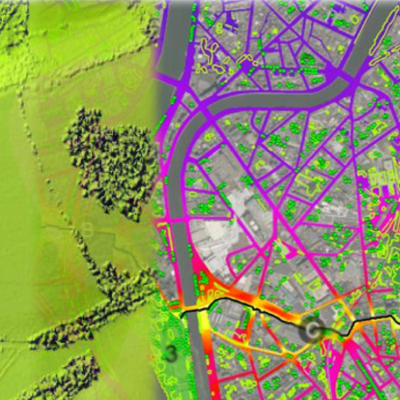The health of our environment depends on a multitude of factors. Academics at Cranfield University have gained expertise in a range of tools and techniques that can facilitate informed decision-making on issues that may adversely affect the state of the environment when mismanaged.
Browse our portfolio of tools that have been developed or extensively used at Cranfield University to address problems affecting the state of the environment and at the same time ensuring economic viability of enterprises.
InVEST (Integrated Valuation of Ecosystem Services and Tradeoffs)
Developed by the Natural Capital Project located at Stanford University, the tool carries out spatially-explicit analyses of ecosystem services supply from a landscape, taking into account landscape context. It can be used to compare different development scenarios at local to regional scales as well as assess change over time, with results shown both in a map and tabular format.
Case study 1
Changes in ecosystem services provision as a result of the introduction of a new road with associated landscaping to the landscape were assessed. The assessment included changes in water yield, nutrient retention, sediment retention, pollination, and carbon sequestration following the development of the scheme over three time milestones with inclusion of the effects of climate change. The results included maps showing the distribution of the hotspots and coldspots of ecosystem services supply as well as graphical summaries of impacts of the new land cover on the ecosystem services supply over time, highlighting both the positive and negative effects.
Case study 2
The InVEST toolkit was used to determine the ecosystem services provision capacity of nature based solutions in water and wastewater treatment complementary to the water quality enhancement. Several ecosystem services models were applied to three sites distributed across Europe and representing three NBS technologies: riverbank filtration, managed aquifer recharge/soil aquifer treatment and constructued wetlands. The outputs estimated both the expected quantities of ecosystem services as well as the impact of the sites on ecosystem services supply from the surrounding landscape.
Publication - Zawadzka J, Gallagher E, Smith H & Corstanje R (2019) Ecosystem services from combined natural and engineered water and wastewater treatment systems: going beyond water quality enhancement, Ecological Engineering: X, 2 (August) Article No. 100006. Dataset/s: 10.17862/cranfield.rd.7994120.v1
The source code and tools are available from the InVEST website.
Contacts
Dr Joanna Zawadzka
Professor Ron Corstanje
Centre for Environmental and Agricultural Informatics
River Condition Assessment
The River Condition Assessment is the habitat assessment method for rivers and streams in the government's new Biodiversity Metric 2.0, which is required for all developments that impact or encrouch on watercourses. The method involves a field survey to identify habitat features and human pressures on the river and quantify a set of indicators for condition. The final condition score is determined by interpreting the preliminary condition score based on the river type, which is assessed based on a desk-based survey.
Case study 1
Biodiversity Net Gain is required for all developments. Biodiversity Metric 2.0 is the latest version of the offsetting / net gain metric, which now has a robust river and streams component. Therefore, all developers, planners and land managers must assess the habitat diversity on any land that will be developed, including an affected rivers using the River Condition Assessment.
Publication - Biodiversity Metric 2.0
Case study 2
The field survey is based on the Modular River Survey (MoRPh), which has been used on many rivers and streams. The indicators have been assessed with a calibration dataset. Reports and articles are available on the MoRPh website.
Publication - Modular River Survey
Case study 3
The River Typing desk-based survey is based on a new EU hydromoprhological assessment framework, which has been applied to a range of case-studies. See the Reform Rivers WP2 deliverables and CEH report on applying the CEN standard.
Publications - River typing and hydromorphological assessment
Gurnell AM & Grabowski RC (2020) An example application of the CEN Water quality — Guidance standard for assessing the hydromorphological features of rivers to the River Frome, Dorset, Southern England. Wallingford, UK: UK Centre for Ecology and Hydrology, ed. 1.
Contact
Strategic risk appraisal
Clients frequently need to appraise complex policy-level risks, risks that are often very diffreent in character. Cranfield's strategic risk apprasial (SRA) tools allow parties to undertake World Economic Forum- and National Risk Assessment-style risk appraisals where large risk issues are appraised alongside one another to allow comparisons and management strategies to be devised.
Case study
The SRA tool starts with the identification and risk screening of key issues, either literature- or/and expert-informed. Disparate policy level risks are then appraised in terms of their environmental, economic and social consequences, together with their likelihoods - with existing management measures assumed to be in place. The positioning of these risks on a heat map stimulates discussions about risk management actions. These tool shave been used widely for Defra and the Environment Agency.
Publications - Prpich, G., Evans, J., Irving, P., Dagonneau, J., Hutchinson, J., Rocks, S., Black, E. and Pollard, S.J.T. (2011) Character of environmental harms – overcoming implementation challenges with policy makers and regulators, Environ. Sci. Technol. 45: 9857–9865.
Garnett, K., Lickorish, F.A., Rocks, S.A., Prpich, G., Rathe, A.A. and Pollard, S.J.T. (2016) Integrating horizon scanning and strategic risk prioritisation using a weight of evidence framework to inform evidence-based, policy decisions, Sci. Tot. Environ. 560/561: 82-91.
Prpich, G., Dagonneau, J., Rocks, SA, Lickorish, F. and Pollard, S.J.T. (2013) Scientific commentary: Strategic analysis of environmental policy risks – heat maps, risk futures and the character of environmental harm, Sci. Tot. Environ. 463/464: 442-445
Contacts
Risk ranking methods
Environmental risks are expressed in terms of the sources, pathways and receptor components that drive the magnitude of the risk outcome. Cranfield risk ranking methods have been used to prioritise source-pathway-receptor relationships and identify risk management outcomes. Cranfield has used these tools widely to identify specific interventions to manage risk, with policy officials, with regulators and commeicla clients.
Case study
These tools have been used to priotise risk management interventions for managing the environmental risks associated with animal disease incursions (avian influenza, foot and mouth disease). The tools consider the complexities of exposure relationships by ranking the potency of hazards, the availability of expsoure pathways and the vulnerability of environmental receptors. They allow clients to identify specific points for intervention and priorities for action. The tools have wide use across all environmental risks where generic risk ranking is required.
Publications
Department for Food, Environment and Rural Affairs (2007) A risk-based review of carcass disposal options in the event of a notifiable exotic animal disease - methodology and application to avian influenza, version 0.9, prepared by Prof. S.J.T. Pollard for the State Veterinary Service, Contingency Planning Division, Contingency Plans and Disposals Branch, Defra, London, 32pp. with appendices
Contact - Professor Simon Pollard
Pollard, S.J.T., Hickman, G.A.W., Irving, P., Hough, R.L., Gauntlett, D.M., Howson, S., Hart, A., Gayford, P. and Gent, N. (2008) Exposure assessment of carcase disposal options in the event of a notifiable exotic animal disease – methodology and application to avian influenza virus, Environ. Sci. Technol. 42(9): 3145-3154.
Contact - Professor Phil Longhurst
Quantitative environmental risk assessment
Site-specific environmental risk assessment relies on detailed, site-specific information to informed detailed quantitative risk models. These are used by clients to identify risk management interventions for location-specific activities or facilities, where site-specific decisions are required. Quantitative risk assessment (QRA) and human health or environmental quantitative risk assessments (HHRRA) draw on environmental monitoring data to estimate exposures and design mitigations.
Case study
Used widely for air quality risk assessment, waste management and bioaerosol risk assessments; widely used for contaimated land assessments. QRA typically deploy cancer and non-cancer toxicological end points to drive quantitative risk estimates. They have been used within environmental impact assessments to quantify potential high risk exposures.
Publications
Gray, D., Pollard, S.J.T., Spence, L., Smith, R. and Gronow, J. (2005) Spray irrigation of landfill leachate: estimating potential exposures to workers and bystanders using a modified air box model and generalised source term, Environ. Pollut. 133: 587-599.
Contact - Professor Simon Pollard
M.P.M. Taha, G.H. Drew, P.J. Longhurst, R. Smith and S.J.T Pollard (2006) Bioaerosol releases from compost facilities: evaluating passive and active source terms at a green waste facility for improved risk assessment, Atmos. Environ., 40: 1159-1169.
Contact - Dr Gill Drew
Drew, G.H., Jordinson, G.M., Smith, M.A. and Pollard, S.J.T. (2009) Evaluating the quality of bioaerosol risk assessments for compost facilities in England and Wales, Res. Conserv. Recyl. 53: 507-512.
Contact - Dr Gill Drew


